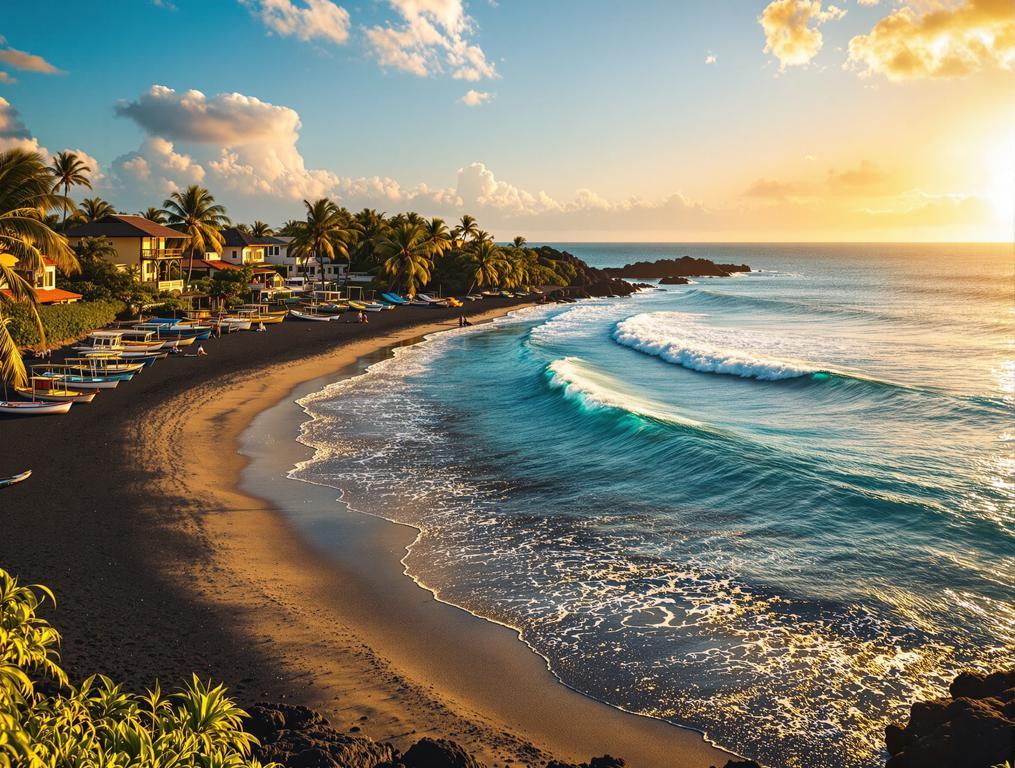I watch the sunrise paint gold streaks across volcanic sands as local fishermen drag wooden boats into the water. El Transito, Nicaragua’s last authentic surf village, comes alive in the gentle morning light. Here, just 2 hours from Managua along a bumpy coastal road, I’ve found what many claim impossible: world-class waves with 90% fewer tourists than nearby San Juan del Sur.
The village of 1,800 residents stretches along a crescent-shaped cove, where dark volcanic sand meets consistent Pacific breaks. What makes this place extraordinary isn’t luxury or convenience — it’s precisely the opposite.
Nicaragua’s Hidden Surf Paradise: Where Locals Outnumber Tourists
The contrast hits me immediately. Unlike California’s tourist hotspots where visitors dramatically outnumber locals, El Transito maintains a delicate balance. Here, on a typical June morning, I count just 12 surfers spread across a mile-long beach.
“We have perfect breaks but no perfect amenities,” explains a weathered fisherman-turned-surf instructor as he repairs a board under a palm tree. “That’s our protection against becoming another San Juan.”
That protection creates the paradox that makes El Transito special. While 60% of locals live on less than $3 per day, they’ve maintained something priceless: authenticity. Fishing remains the primary livelihood, with surf tourism providing supplemental income without overwhelming local culture.
Walking the beach, I discover remnants of 17th-century pirate fort ruins jutting from coastal rocks. Local legend claims treasure remains buried nearby, though no documented discoveries exist. Children play soccer around these historical fragments as if they’re ordinary playground equipment.
The Anti-San Juan del Sur Experience
While El Transito offers Nicaragua’s most consistent uncrowded waves, those seeking longer pristine coastlines might also consider Colombian beaches without crowds just a short flight away. But what makes this village special is its unpolished character.
San Juan del Sur, 90 minutes south, welcomes 40,000+ annual tourists with bars, hostels, and organized excursions. El Transito offers none of that. Instead, you’ll find two basic hostels, camping under the stars, and daily fish auctions directly on the beach.
“I came for two days and stayed two weeks. There’s something magical about a place where your morning alarm is fishermen singing to each other as they launch their boats, not party music or construction.”
The tight-knit fishing community values traditions much like Spain’s best-kept secrets where local culture remains authentic and unspoiled by mass tourism. Families gather at sunset, sharing freshly caught fish grilled on makeshift palapas with visitors welcome to join for $5 per plate.
El Transito’s volcanic sands contrast with Cuba’s hidden paradise beaches, offering travelers in Central America diverse coastal experiences. Here, the dark sand burns hot midday but retains warmth during evening beach gatherings.
What The Guidebooks Won’t Tell You
Visit during June through August to experience the perfect balance — consistent waves without Easter crowds or dry-season tourists. The morning offshore winds create glass-like conditions until 11am, with afternoon onshores ideal for beginners.
Access requires determination. The final 12 kilometers remain unpaved, with motorcycle rental from León ($25/day) offering the most reliable transport. Bring cash; there are no ATMs and cell service remains spotty at best.
The village transformation during Easter Week is dramatic, with vacation homes suddenly occupied and beach population swelling tenfold. For authentic experience, avoid this period entirely.
Camping directly on the beach costs $5 per tent, with informal community oversight ensuring safety. If seeking slightly more comfort, two hostels offer basic rooms from $15-25 per night, often including breakfast and surf lessons.
As I pack to leave, my 7-year-old daughter Emma asks when we can return. I explain that places like El Transito exist in a delicate balance, and Sarah captures one final photo — a local fisherman teaching a visiting surfer to repair a board using hand-mixed epoxy. It perfectly embodies what makes this place special — the exchange between worlds without either losing its soul. Like Nicaragua itself, El Transito doesn’t try to be anything but what it is: beautifully, defiantly authentic.
